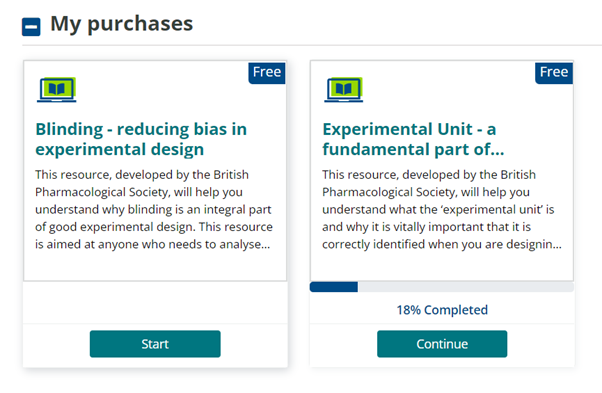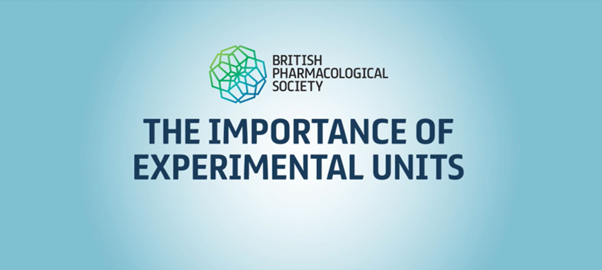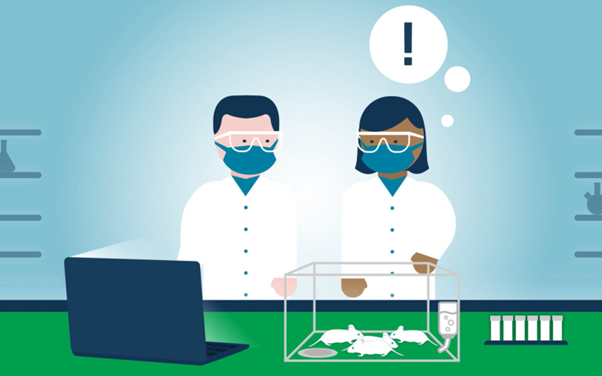On 12 May 2022, the British Pharmacological Society launched the latest free-to-use undergraduate eLearning resource on the topic of Experimental Design. This resource covers the importance of experimental units.

Why have we developed this eLearning resource?
The British Pharmacological Society has supported education and training in pharmacology for many years. Translation of biomedical research into safe and effective medicines is only possible if experimental outcomes are reproducible and reliable.
Preclinical in-vivo pharmacology and PKPD modelling has long been recognised by the ABPI as a field with skills shortages. For example, in their most recent report the ABPI highlights a need for improved understanding of the use of physiological modelling and statistics by a future workforce. To address these skills shortages the Society’s curriculum for the use of research animals, which is relevant to undergraduates and taught masters on any bioscience degree programme, was launched in 2017. Since then, the Society has supported educators and their students by producing resources that are aligned with the curriculum.
Our free eLearning content comprises of a series of separate modules that are proving popular amongst educators and undergraduate students. The first of these focusses on the topic of ‘Blinding’ and explains how to blind a study and why this process is essential for all experiments to reduce bias. This resource package includes:
- a short animation video explaining the importance of blinding an experiment
- formative multiple-choice questions providing a knowledge check
- an advanced literature review task
Feedback from educators confirms that this package works extremely well, not least because it can be used flexibly, in the classroom or remotely, either as a free-standing resource or to supplement other course materials. It is recognised that spare capacity in timetables and time for educators to create their own content are limited, and so this blended learning tool was designed to complement other approaches to teaching without excessively increasing students’ or educators’ time burden.
What does the Experimental Unit resource cover?

The aim of the series of resources is to help undergraduate students understand the key principles of experimental design, why they are important and what can go wrong if they are ignored. The latest resource, on the Experimental Unit, starts with a series of learning objectives. This is followed by a four minute animation that describes a hypothetical experiment in which samples are to be collected from animals that have been treated with either a drug or its vehicle. It explains why making a decision on whether or not the drug has had an effect involves comparing the magnitude of the response to the drug to the background variation in the measure of interest (the ‘signal’ to ‘noise’ ratio). However, the animation emphasises that this comparison depends on a correct assessment of the background variation, for which identification of the ‘Experimental Unit’ is essential.
The first scenario in the animation deals with a simple experiment with only two groups (test and control), but this is followed by more complex scenarios, all of which are often encountered in the biomedical sciences. The aim here is to help researchers distinguish between experimental units and technical replicates. For instance, the animation compares two experimental scenarios that are apparently similar but, in one case, the mother of a litter of pups is the Experimental Unit whereas, in another, each pup qualifies as an Experimental Unit. Experiments carried out in-vitro are also considered, and the animation has an example that raises the question of whether individual cells (or triplicates of cells) in a multi-well plate, or the whole plate, is the Experimental Unit.
Following the animation, there is a series of formative multiple-choice questions; these become progressively more difficult and so check students’ understanding of the concept of the Experimental Unit in a range of different types of experiments.
How to access the resource
The resource is freely accessible from the BPS Assessment website. Once you register, you can access the educational resources on the site; scroll down to the last of the series where you will find the resources for Blinding and Experimental Unit. Clicking on either of those will enable you to access and activate the animation and other content.
The animation in isolation is also available via the BritPharmSoc YouTube channel.

Who was involved in the resource development?
The development of the portfolio of resources for Experimental Design has been managed by Lee Page, Head of Education and Engagement at the BPS. The first, on Blinding, was led by Dr Jude Hall, who devised the learning objectives, the storyboards for the animation and the formative exercises that followed. This content was reviewed during development by a series of BPS members, bioscience educators, researchers and with NC3Rs. This resource has been popular and so we adopted a similar process for the Experimental Unit resource to ensure a clear and distinctive identity across the series of resources.
This new development was led by Prof Clare Stanford, but again included a peer review process during the content development with a wide range of experts, including the NC3Rs team who developed the Experimental Design Assistant, the BPS Education Committee and other members of the BPS who are experts in experimental design and education. The final versions of both resources took account of all this helpful input.
Moving forward, we intend to continue developing more eLearning content like this resource on the theme of Experimental Design. The next one will cover ‘choosing the right experimental process’ - meaning a pilot study, hypothesis-generating study or confirmatory study - and will look at some of the experimental factors to consider for these types of experiments.
Feedback so far
We welcome feedback on this project anytime at education@bps.ac.uk either on the content itself or to suggest future topics. Here is some of the feedback so far.
“This resource is exactly what we are looking for and fits perfectly for our updated module at Manchester. The flexibility of the resource means it will be useful in lots of ways. We will use it and look forward to seeing more in the future.” - Dr Susan Cochran, University of Manchester.
“It is great to see this eLearning approach continue and in time cover the Experimental Design topic more fully. Both blinding and now experimental unit are great examples of flexible learning tools in an area of great need.” - Dr Manasi Nandi, Kings College London.
“Free access, simple to use and all in one place- perfect for students and educators alike. The experimental unit animation is particularly useful, helping me visualise the key concepts with the examples provided. I can’t wait to see the expansion of this eLearning resource- it's exciting” - Weston James (Final year pharmacology student at University of East Anglia)
Comments
If you are a British Pharmacological Society member, please
sign in to post comments.